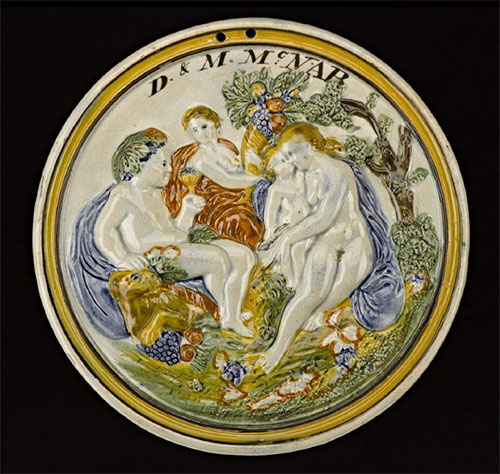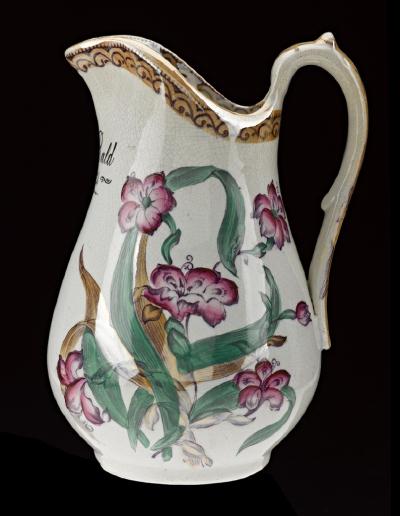Our Scotland Creates volunteers are working with curators and other staff from National Museums Scotland and four partner museums, including the McLean Museum and Art Gallery in Greenock, to create an exhibition on the theme of Scotland Creates: A Sense of Place. The exhibition, ‘Colour, Design and Creativity, An exhibition inspired by the Clyde Pottery, Greenock (1816 – 1905)’ opens at the McLean Museum on 10 August and runs until 21 September 2013.
As the oldest known piece of Clyde Pottery, this small earthenware plaque will take pride of place as part of the McLean Museum’s Scotland Creates: A Sense of Place exhibition this summer. The piece, which is on loan from National Museums Scotland, was discovered in an Edinburgh junk shop in the 1960s, yet, since its discovery very little has been learnt about it. The plaque is clearly marked ‘D. & M. McNab’ and its reverse inscribed ‘Greenock Pottery 1818’. It is assumed to be commemorative. But for whom? Or what?

The Clyde Pottery Company, under several guises, produced wares in Greenock from the early nineteenth century until the factory’s final demise in 1905. The pottery became extremely important to Greenock and the surrounding areas. Many people found employment at the factory or in its associated flint mill and retail outlets. Greenock has its own ‘Pottery Street’, where the famous factory once stood, and many local people still treasure its wares as family heirlooms. At one point, the area was even known as ‘the Greenock Potteries.’ Given the theme of the exhibition, how the creativity of Scotland’s past has created the Scotland that we know today, I decided it was important to know more about the plaque and started digging around…
Making use of my somewhat mediocre knowledge of undergraduate Classics, it is clear that the figure on the left is Dionysus: he wears a crown of vine leaves and raises a glass of wine in a toast with one hand. Dionysus is shown seated upon a lion, an animal that he transforms into several times in ancient Greek mythology. The abundant fruit and grapevines symbolise Dionysus as god of the harvest. Dionysus is most traditionally depicted alongside nymphs, or maenad, so this is a plausible identity for the other pictured figures. In the true spirit of Greek mythology, there are reportedly at least two nymphs – Nicaea and Aura – who had children with Dionysus, so this potentially explains the smallest figure in the scene. Alternatively, the baby could be seen as a stylistic representation of Dionysus himself, who was raised by nymphs. Either way, the scene is intended as a lighthearted one of plenty: life, wine and rich harvest.
The next figures featured on the plaque that I needed to identify were, obviously, D. and M. McNab. Given the scene it depicts, it is natural to presume that the McNabs were wine merchants, or involved in a similar commercial venture. I checked out local trade directories, archives and even contemporary shipping registers, but to no avail. In later years, individually decorated pieces made to commemorate local weddings became somewhat of a Clyde Pottery tradition. However, the way the McNab plaque is dedicated does not really fit with this tradition and I could find no matching marriages anywhere in Scotland, let alone specifically in Greenock. I felt a sense of panic that I would never learn anything new about this piece.
However, by a ridiculous stroke of good luck, a remarkably similar item was sold during my research for the museum’s exhibition. This plaque, of the same size and markedly similar relief scene, was dated to around 1790. This earlier plaque was considered to be Scottish given the McNab Plaque, which is marked ‘Greenock’ as previously noted. However, there is no evidence at all – literary or archaeological – for a pottery at Greenock of any kind before 1810. Given this piece’s earlier date and its consideration as a very fine example of ‘Prattware’ – cream earthenware, the relief hand-painted and then glazed – it is more likely to have been produced in the Staffordshire Potteries, specifically the Pratt pottery works at Fenton.
Significantly, the first Clyde Pottery manager, recruited by company owners Andrew and James Muir, was James Stevenson, part of a skilled and well-known family of potters originally from Cobridge, Staffordshire, just a few miles away from the Pratt factory. Other skilled Staffordshire pottery workers were also encouraged to Greenock. It is natural to assume that the Muir brothers also imported physical aids for their new pottery business, such as tools, moulds and designs, as well as the skills and techniques needed to use them. Interestingly, it is noted that the clear definition of this earlier plaque’s relief moulding suggests a piece cast from a new or little used mould. Could the McNab plaque, therefore, be a later product of the same mould?

The two plaques are both just over seven inches (18cm) in diameter, and despite being painted in different colours their reliefs are almost identical. Yet there are some significant differences: their respective Dionysus figures toast with glasses of differing shapes and, in the McNab plaque, the female figure in the background does not wear a headdress. Perhaps more expert analysis could determine whether or not the McNab plaque could have been made using the same mould as its earlier cousin after it had been altered or even restored after over use. The McNab plaque could also potentially be a copy of this earlier, finer piece, perhaps made during the course of an apprenticeship. Even so, this would still point to knowledge of the original plaque or mould in Staffordshire.
Who D. and M. McNab were, I cannot say. However, the McNab plaque itself does seem to paint a picture of how local businessmen and entrepeneurs in the busy port of Greenock often used the town’s trade routes and connections to draw in skills and ideas and create something more specifically local and Scottish. What is most significant about the McNab plaque, therefore, is what it suggests about the Clyde Pottery’s establishment and development, and in turn how Greenock’s Pottery street factory helped to create a sense of place.
